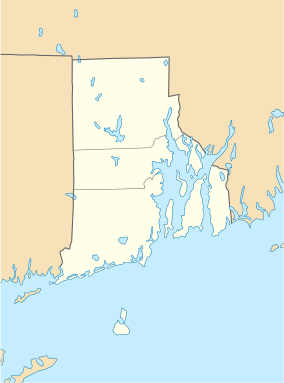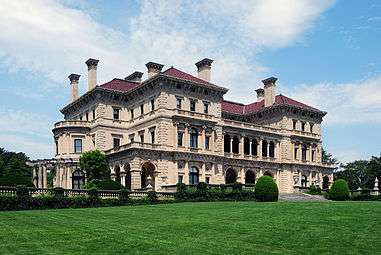Isaac Bell House
|
Isaac Bell House | |
|
Front elevation, 2008 | |
  | |
| Location | 70 Perry Street, Newport, RI |
|---|---|
| Coordinates | 41°28′45.75″N 71°18′35.06″W / 41.4793750°N 71.3097389°WCoordinates: 41°28′45.75″N 71°18′35.06″W / 41.4793750°N 71.3097389°W |
| Area | 1 acre (0.40 ha) |
| Built | 1881-1883 |
| Architect | McKim, Mead and White |
| Architectural style | Shingle style |
| Part of | Bellevue Avenue Historic District (#72000023) |
| NRHP Reference # |
72000022 (original) 97001276 (NHL) |
| Significant dates | |
| Added to NRHP | January 13, 1972[1] |
| Designated NHL | September 25, 1997[2] |
| Designated NHLDCP | December 8, 1972 |
The Isaac Bell House is a historic house and National Historic Landmark at 70 Perry Street (at its corner with Bellevue Avenue) in Newport, Rhode Island. Also known as Edna Villa, it is one of the outstanding examples of Shingle Style architecture in the United States. It was designed by McKim, Mead, and White, and built during the Gilded Age, when Newport was the summer resort of choice for America's wealthiest families.
History
Isaac Bell, Jr. was a successful cotton broker and investor, and the brother-in-law of James Gordon Bennett, Jr., publisher of the New York Herald. Bell hired the New York architectural firm of McKim, Mead, and White (Charles Follen McKim, William R. Mead, and Stanford White) to design his summer cottage. Known in Newport for designing Newport Casino, and later in Boston for designing Boston Public Library, they also designed the famous Pennsylvania Station in New York. Construction took place between 1881 and 1883.
The Shingle Style was pioneered by Henry Hobson Richardson in his design for the William Watts Sherman House, also in Newport. This style of Victorian architecture was popular in the late nineteenth century and named after the extensive use of wooden shingles on the exterior. The Isaac Bell House exemplifies the style through its unpainted wood shingles, simple window & trim details, and multiple porches. It combines elements of the English Arts and Crafts movement philosophy, colonial American detailing, and features a Japanese-inspired open floor plan and bamboo-style porch columns. Interior features include inglenook fireplaces, natural rattan wall coverings, wall paneling and narrow-band wooden floors.
The building's history includes being split up into apartments and serving as a nursing home. With the help Carol Chiles Ballard, the house was bought in 1994 by the Preservation Society of Newport County, which won awards for its restoration, and now operates it as a house museum.
The Isaac Bell House was declared a National Historic Landmark in 1997.[2][3]
- Isaac Bell House interior featured in 1886
See also
-
 Rhode Island portal
Rhode Island portal - List of National Historic Landmarks in Rhode Island
- National Register of Historic Places listings in Newport County, Rhode Island
References
- ↑ National Park Service (2006-03-15). "National Register Information System". National Register of Historic Places. National Park Service.
- 1 2 "Isaac Bell House". National Historic Landmark summary listing. National Park Service. Retrieved 2008-05-04.
- ↑ John Tschirch; Diane D. Galt; Fred Stachura; Susan Kline; Carolyn Pitts (December 18, 1996). "National Register of Historic Places Inventory-Nomination: Isaac Bell, Jr. House / Edna Villa" (pdf). National Park Service. and Accompanying ten photos, exterior and interior, from c.1886, 1950, 1973, 1994, 1995, and undated (32 KB)
External links
| Wikimedia Commons has media related to Isaac Bell House. |
- Isaac Bell House
- Historic American Buildings Survey (HABS) No. RI-308, "Isaac Bell House, 70 Perry Street, Newport, Newport County, RI", 10 photos, 8 measured drawings, 14 data pages
- 2001 Victorian Society Award
- Gilding and wallpaper reproduction firm
- Historic carpet reproduction firm

